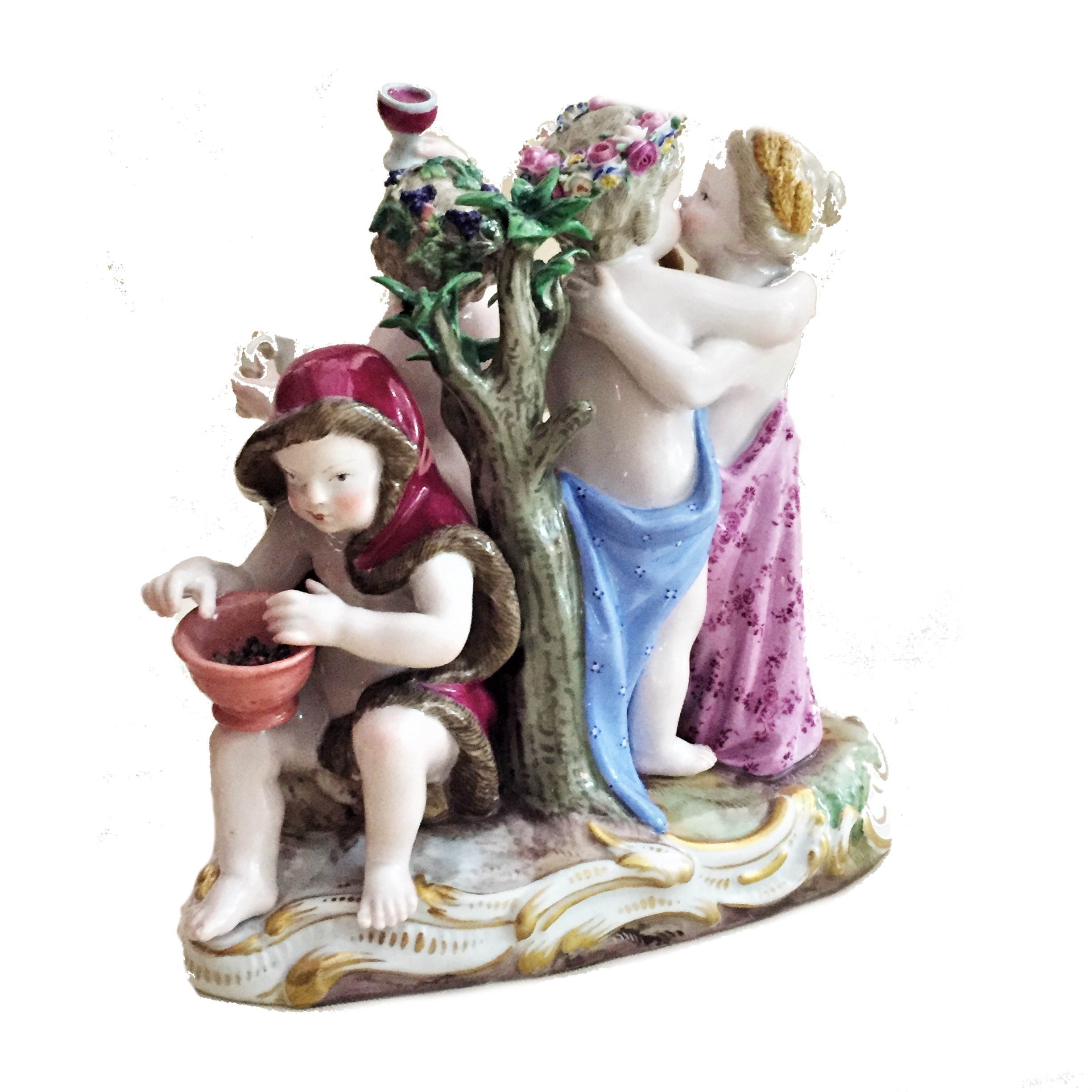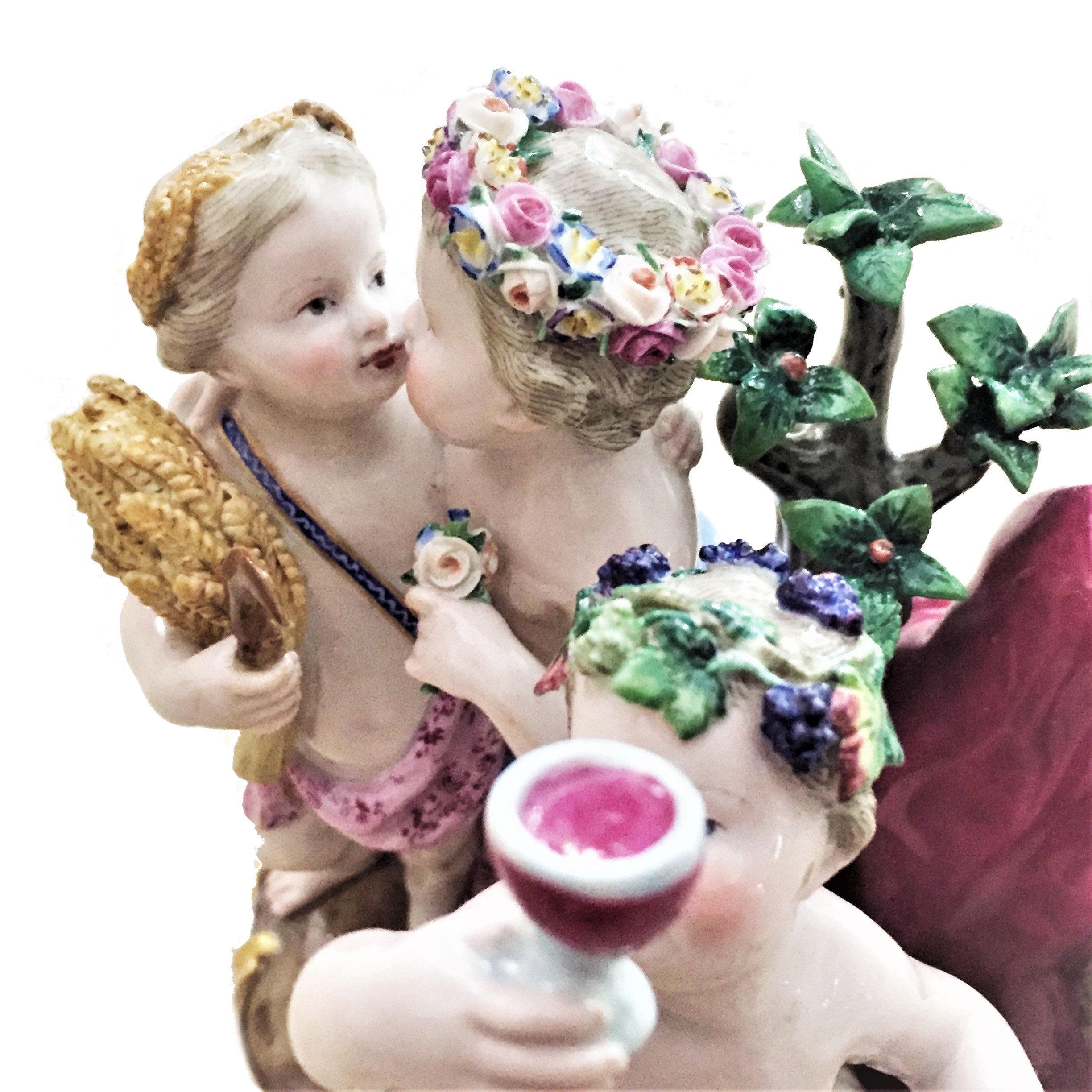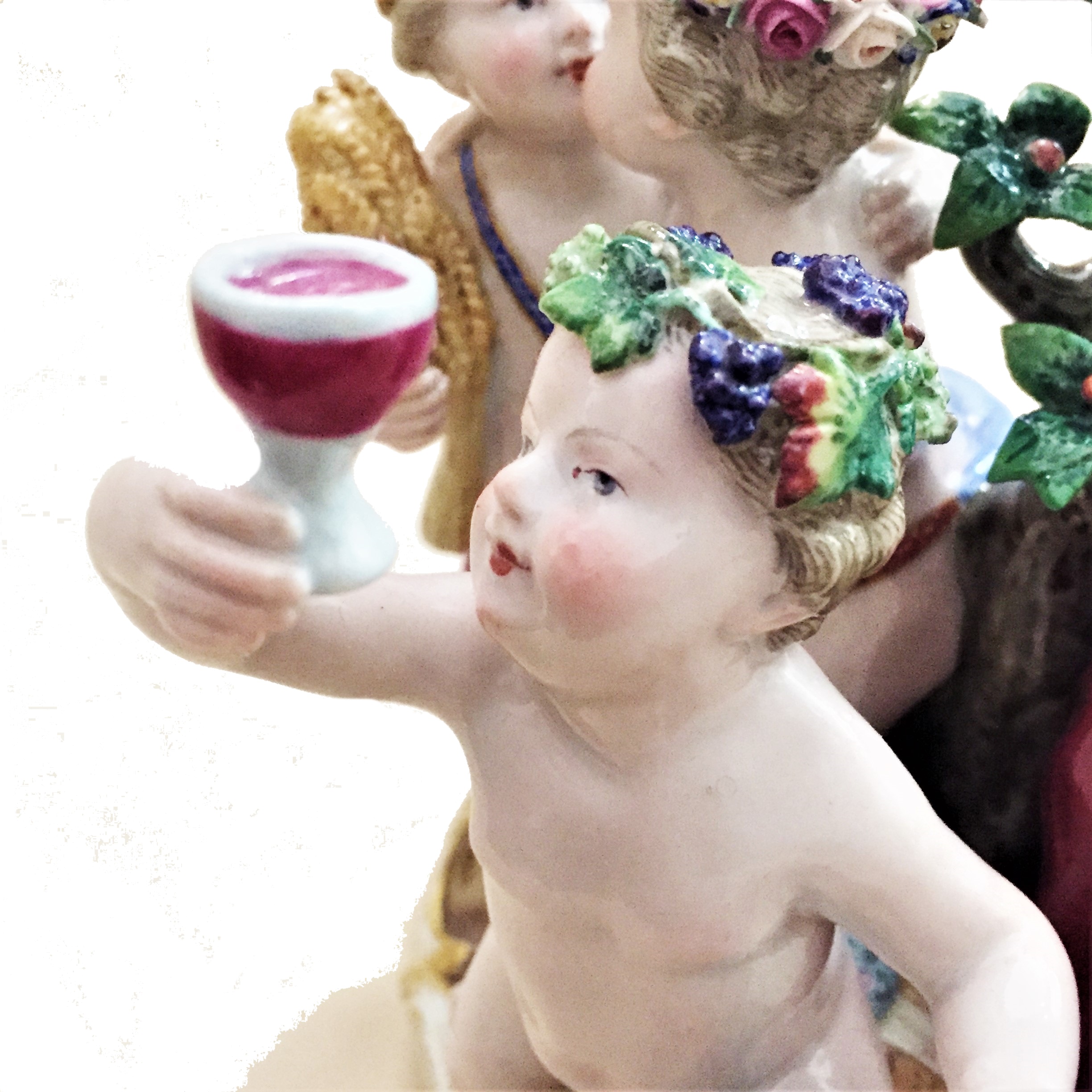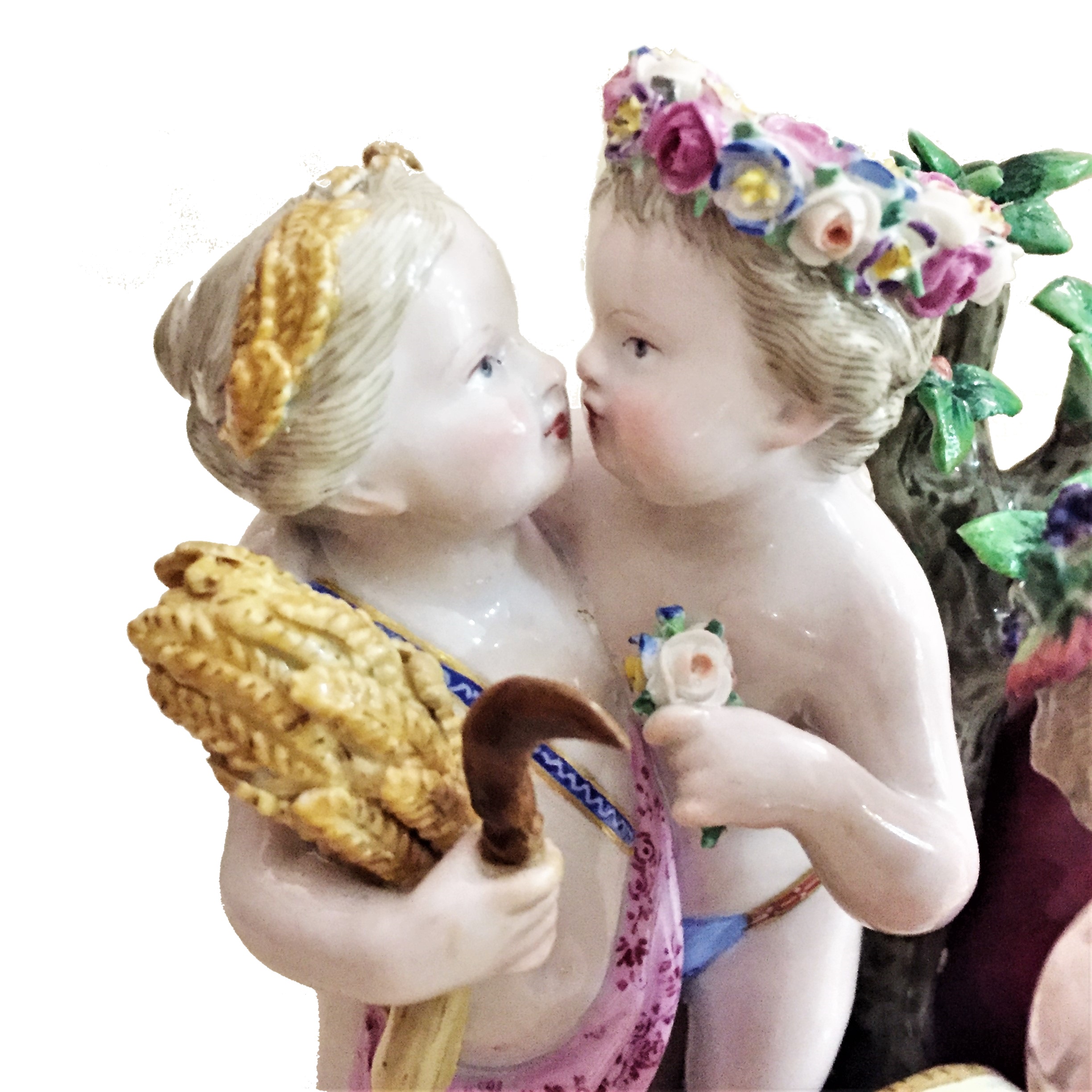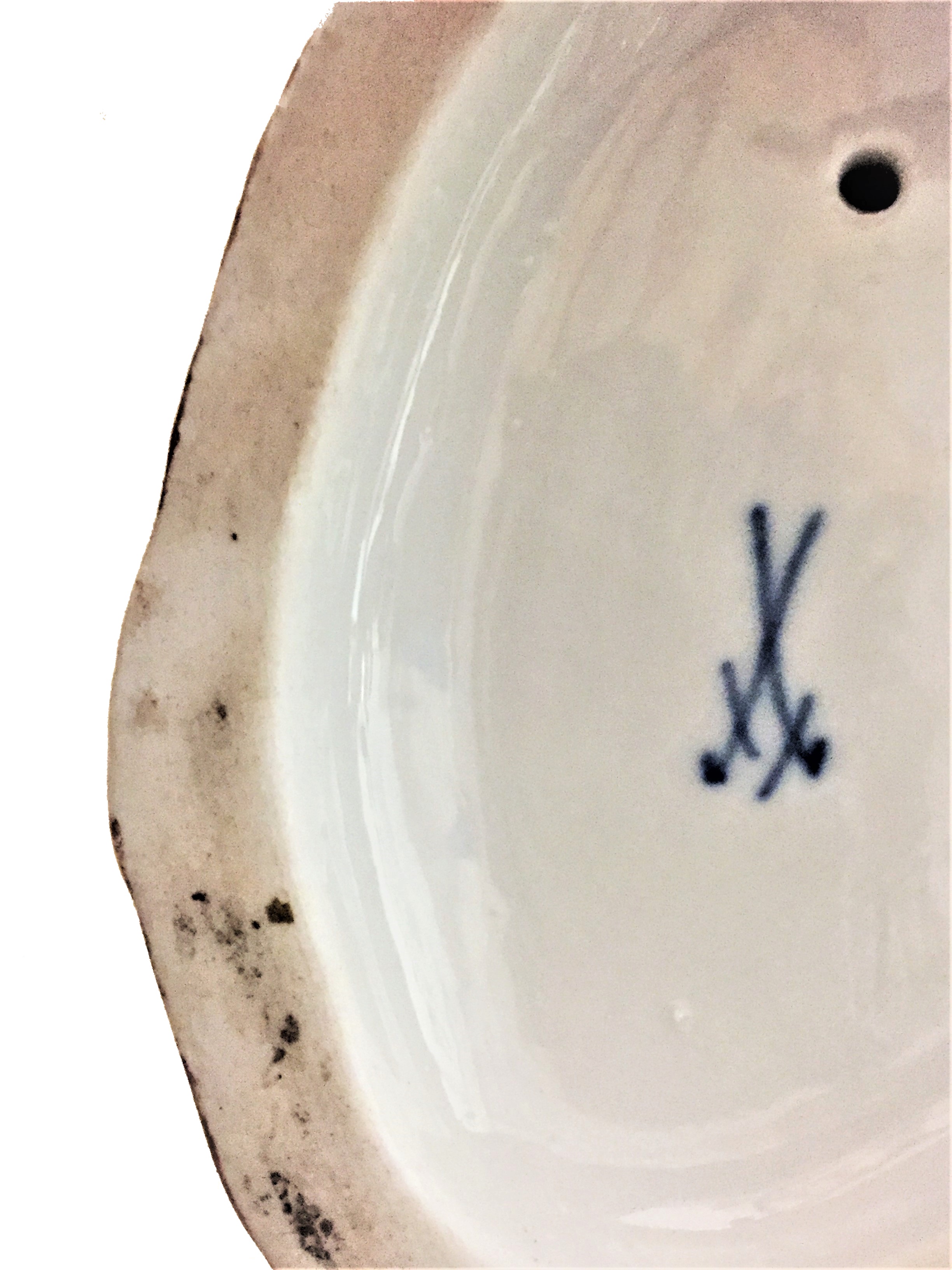French Neoclassical Movement
Sevres ~ Flower Vase
Two-Tone Blue Porcelain & Bronze-Doré
ca. 1756-1761
ABOUT
This flower vase, extraordinary in its beauty and laconic design, made of two-ton blue porcelain, mounted in gilded bronze, was made by the Sevres manufactory in the second half of the 18th century; as evidenced by the deciphering of the brand hallmark with this particular model production years (“C” – 1756 | “H” – 1761) on the outside of the bottom of the vase.
DIMENSIONS
Height: 18.5 inches Width: 6.5 inches Depth: 5.5 inches
sold
Capodimonte
The Abduction of the Sabine Women
Porcelain Wall Plaque
XIX Century
Marked with Capodimonte porcelain mark on the reverse.
Original intricate wood and bronze frame, decorated with semi-precious stones.
Dimensions: Height: 14.5 inches (36.25cm) Width: 12.25 inches (30.62cm) Depth: 0.75 inches (1.82cm)
The Abduction of the Sabine Women, or the Sabine War, is an episode dating back to a legendary period in Roman history. Rome was inhabited by men alone; neighboring tribes did not want to give their daughters in marriage to the poor population of Rome. Then Romulus arranged the Consulius holiday and invited the neighbors. They came with their families. During the holiday, the Romans suddenly rushed at the unarmed and kidnapped their girls. Outraged neighbors started a war. The Romans defeated the Latins who attacked Rome. Much more difficult was the war with the Sabines, who lost especially many women. With the help of the daughter of the head of the capitol fortress Tarpei, the Sabines took possession of the Capitol. The struggle went on for a very long time. The Sabines, under the command of King Titus Tatius, finally defeated the Romans and put them to flight. Romulus appealed to the gods and promised to build a temple to Jupiter Stator (Stopover) if he stopped the fleeing. At this decisive moment, the Sabine women, already attached to their Roman husbands and having children from them, with their hair loose and in torn clothes, rushed between the fighters and began to beg them to stop the battle. The Sabines agreed, and an eternal peace was concluded, according to which the two peoples united into one state under the supreme leadership of Titus Tatius and Romulus. The Romans had to bear, in addition to their name, also the Sabine name - quirits. Religion became common. Thus, the women saved Rome. According to the Fasti Triumphales, the day of reconciliation with the Sabines took place on March 1, 752 BC. In memory of this event, Romulus instituted the festival of Maturnalia and gave women many honorary rights.
SOLD
Royal Vienna Porcelain
A Group of Children Playing Wedding
1915
Dimensions: Height: 7.13 inches (17.82cm) With: 11.75 inches (29.37) Depth: 4.5 inches (11.25cm)
This wonderful porcelain sculptural group depicting children playing in an 'adult wedding’ conveys with surprising accuracy the emotional component of the moment, conveyed in the expression of children's faces.
THE ROYAL VIENNA PORCELAIN MANUFACTORY (German: Kaiserlich privilegierte Porcellain Fabrique) was a porcelain manufacturer in Alsergrund in Vienna, Austria. It was founded in 1718 and continued until 1864. The firm was Europe's second-oldest porcelain factory after Meissen porcelain, and for 25 years the two remained the only European producers. Initially it was a private enterprise, founded by Claude du Paquier,[ an official of the Viennese Imperial court, but in 1744 it was rescued from financial difficulties when bought by the Empress Maria Theresa, and thereafter remained an asset of the emperors. The Imperial State Manufactory Vienna (the original Royal Vienna porcelain works) made porcelains from 1744 to 1864, when it closed. ... After 1864, many other small factories in Austria were permitted to use the name "Royal Vienna," and they often used the underglaze beehive mark.
$5,500
Meissen
Mandolin Player & Woodcutter
A Pair of antique porcelain figurines
ca. 1860’s
Hallmarked with Meissen crossed swords and numbered ‘18’on the bottom of both bases.
Dimensions:
Mandolin Player: Height: 4.07 inches (10.17cm) Width: 2.25 inches (5.62cm) Depth: 1.88 inches (4.7cm)
Woodcutter: Height: 4.07 inches (10.17cm) Width: 1.88 inches (4.7cm) Depth: 2.75 inches (6.87cm)
Executed in the best traditions of Meissen, this lovely pair of statuettes depicts a female mandolin player and a woodcutter, where a musician entertains the laborer while he is occupied with his work.
MEISSEN porcelain or ‘Meissen china’ was the first European hard-paste porcelain. Early experiments were done in 1708 by Ehrenfried Walther von Tschirnhaus. After his death that October, Johann Friedrich Bottger continued von Tschirnhaus's work and brought this type of porcelain to the market, financed by Augustus the Strong, King of Poland and Elector of Saxony. The production of porcelain in the royal factory at Meissen, near Dresden, started in 1710 and attracted artists and artisans to establish, arguably, the most famous porcelain manufacturer known throughout the world. Its signature logo, the crossed swords, was introduced in 1720 to protect its production; the mark of the swords is reportedly one of the oldest trademarks in existence. In English Dresden porcelain was once the usual term for these wares, especially the figures; this is because Meissen is geographically not far from Dresden, which is the Saxon capital. Meissen remained the dominant European porcelain factory, and the leader of stylistic innovation, until somewhat overtaken by the new styles introduced by the French Sevres factory in the 1760s, but has remained a leading factory to the present day. Among the developments pioneered by Meissen are the porcelain figurines, and the introduction of European decorative styles to replace the imitation of Asian decoration of its earliest wares. Since 1991, the manufactory has been operating as the Staatliche Porzellan-Manufaktur Meissen GmbH, whose owner is the Free State of Saxony. The company is one of the world's leading porcelain manufacturers and one of the oldest and most internationally known German luxury brands.
$2,800
Carl Thieme
A Noble Gentleman in Love
Antique Dresden Porcelain Figurine
ca. 1870’s
Hallmarked with Carl Thieme’ 1870’s porcelain mark in form of a crown over capital ‘N’.
Dimensions: Height: 5.44 inches (13.6cm) With: 2.75 inches (6.87cm) Depth: 2.63 inches (6.57cm)
Sächsische Porzellan-Fabrik Carl Thieme zu Potschappel - Carl-Johann Gottlob Thieme started in 1864 in Dresden porcelain and antique shop. He was also running a porcelain painting business. In September 1872 he established a porcelain factory named Sächsische Porzellan-Fabrik Carl Thieme zu Potschappel. Carl Thieme died in 1888. The business was taken over in 1896 by his talented son in law, Karl August Kuntsch. Kuntsch was a modeler who started a tradition of flower decorations traditional for Dresden style porcelain items. He died in 1920. His widow and two sons (Carl August and Emil Alfred)run the company in next years. After the WWII in 1951 Emil Kuntsch was pushed out of the company and the state gradually increased its involvement in next years. 1972 the company was fully nationalized and till 1990 operated as VEB Sächsische Porzellan-Manufaktur Dresden. In 1991 the company was reprivatized.
sold
Meissen
A Grieving Cupid
Antique Porcelain Figurine
ca. 1860’s
Hallmarked with Meissen crossed swords and numbered ‘18’ on the bottom of the base.
Dimensions: Height: 7.13 inches (17.82cm) With: 3.63 inches (9.07cm) Depth: 3.38 inches (8.45cm)
Executed in the best traditions of Meissen, this exceptionally fine statuette depicts a cupid with a suffering expression on his face and an empty quiver of arrows at his feet. This composition instantly evokes an unambiguous emotion in the viewer – the love is gone.
MEISSEN porcelain or ‘Meissen china’ was the first European hard-paste porcelain. Early experiments were done in 1708 by Ehrenfried Walther von Tschirnhaus. After his death that October, Johann Friedrich Bottger continued von Tschirnhaus's work and brought this type of porcelain to the market, financed by Augustus the Strong, King of Poland and Elector of Saxony. The production of porcelain in the royal factory at Meissen, near Dresden, started in 1710 and attracted artists and artisans to establish, arguably, the most famous porcelain manufacturer known throughout the world. Its signature logo, the crossed swords, was introduced in 1720 to protect its production; the mark of the swords is reportedly one of the oldest trademarks in existence. In English Dresden porcelain was once the usual term for these wares, especially the figures; this is because Meissen is geographically not far from Dresden, which is the Saxon capital. Meissen remained the dominant European porcelain factory, and the leader of stylistic innovation, until somewhat overtaken by the new styles introduced by the French Sevres factory in the 1760s, but has remained a leading factory to the present day. Among the developments pioneered by Meissen are the porcelain figurines, and the introduction of European decorative styles to replace the imitation of Asian decoration of its earliest wares.
Since 1991, the manufactory has been operating as the Staatliche Porzellan-Manufaktur Meissen GmbH, whose owner is the Free State of Saxony. The company is one of the world's leading porcelain manufacturers and one of the oldest and most internationally known German luxury brands.
SOLD
Meissen
a Lame Cherub on Crutches
Antique porcelain figurine
ca. 1880’s
Hallmarked with Meissen crossed swords and numbered ‘18’ on the bottom of the base.
Dimensions: Height: 8.38 inches With: 3.63 inches Depth: 4.63 inches
This delicate statuette, amazing in its plot and executed in the best traditions of Meissen, depicts a charming cherub with a sad face expression, who has injured his leg and is leaning on homemade crutches. It evokes in the viewer compassion and a smile of tenderness at the same time.
MEISSEN porcelain or ‘Meissen china’ was the first European hard-paste porcelain. Early experiments were done in 1708 by Ehrenfried Walther von Tschirnhaus. After his death that October, Johann Friedrich Bottger continued von Tschirnhaus's work and brought this type of porcelain to the market, financed by Augustus the Strong, King of Poland and Elector of Saxony. The production of porcelain in the royal factory at Meissen, near Dresden, started in 1710 and attracted artists and artisans to establish, arguably, the most famous porcelain manufacturer known throughout the world. Its signature logo, the crossed swords, was introduced in 1720 to protect its production; the mark of the swords is reportedly one of the oldest trademarks in existence. In English Dresden porcelain was once the usual term for these wares, especially the figures; this is because Meissen is geographically not far from Dresden, which is the Saxon capital. Meissen remained the dominant European porcelain factory, and the leader of stylistic innovation, until somewhat overtaken by the new styles introduced by the French Sevres factory in the 1760s, but has remained a leading factory to the present day. Among the developments pioneered by Meissen are the porcelain figurines, and the introduction of European decorative styles to replace the imitation of Asian decoration of its earliest wares.
Since 1991, the manufactory has been operating as the Staatliche Porzellan-Manufaktur Meissen GmbH, whose owner is the Free State of Saxony. The company is one of the world's leading porcelain manufacturers and one of the oldest and most internationally known German luxury brands.
$1,350
Antique German
KPM Porcelain
Group of Bacchus and Aphrodite’ Feast
XIX Century
Hallmarked ‘KPM’ and numbered ‘303’ on the bottom of the base.
Dimensions: Height: 9.88 inches (24.7cm) With: 9.25 inches (23.12cm) Depth: 8.75 inches (21.87cm)
This exquisite KPM Porcelain Mythological Group of feasting Bacchus depicts Dionysus (also called Bacchus - a nature god of fruitfulness and vegetation, especially known as a god of wine and ecstasy), sitting on wine barrel and holding grapes in one hand and goblet in the other. The very cheerful Bacchus is surrounded by Aphrodite, the goddess of beauty, love, pleasure, sexuality and procreation and three winged cherubs, assisting them by opening a wine bottle and pouring wine into their goblets. With a goat at her feet, she displays a wicker basket full with ripe bunches of grapes, rejoicing in a rich harvest.
KPM - The Royal Porcelain Factory in Berlin (German: Königliche Porzellan-Manufaktur Berlin, abbreviated as KPM), also known as the Royal Porcelain Manufactory Berlin and whose products are of hard-paste porcelain, generally called Berlin porcelain. It was founded in 1763 by King Frederick II of Prussia (known as Frederick the Great).
$5,750
European Art Deco
Head of Jester
Vintage Porcelain Sculpture
ca. 1930s
Probably German.
Unmarked and unsigned.
Dimensions: Height: 6.75 inches (16.9cm) Width: 6.75 inches (16.9cm) Depth: 7 inches (17.5cm)
sold
Sèvres
Cobalt Blue Porcelain and Ormolu-Mounted
Three-Piece Clock Garniture
France, Ca. 1950’s
This rare French Renaissance Revival garniture, consisting of a clock and pair of boxes in form of chalices with hinged bonnets, is richly decorated with numerous hand-painted medallions, depicting historical personages of medieval French nobility during the period.
CLOCK DIMENSIONS: Height: 12-3/4” Width: 12” Depth: 7-1/4”
CHALICE BOX DIMENSIONS: Height: 11-1/4” Width: 5-3/4” Depth: 4-1/2”
$8,500
French Art Deco
Concubine on an Elephant
Porcelain Electric Perfume Lamp
ca. 1920’s
Dimensions: Height: 7-1/4 inches Width: 3-7/8 inches Depth: 6-1/2 inches
This unusual porcelain electric perfume lamp depicts a concubine on an elephant, and probably was part of a boudoir décor of some sophisticated Parisian lady during the Art Deco era. Unmarked.
PERFUME/FRAGRANCE LAMPS: In the unsanitary world of the 18th and 19th century, bad smells were everywhere. There was no garbage pickup, no indoor flushing toilets and no refrigeration to keep food from spoiling. In the 1800s, a special lamp was used to remove the strong odors in hospitals and mortuaries. It was a catalytic lamp that burned an alcohol-based fuel. A cotton wick burned for a few minutes to heat a stone. After the flame was out, the heated stone turned odors into carbon dioxide and water. In 1897, a Frenchman improved the lamp by adding perfume to the fuel to make a scented room. Many lamps were made in figural shapes suitable for a living room or bedroom. In the Art Deco era, perfume lamps began to heat with electricity.
SOLD
Richard Eckert & Co.
Artist and his Model
German Porcelain Group
ca. 1890s
Dimensions:
Height: 6.75 inches Width: 5 inches Depth: 5 inches
This porcelain group produced by Richard Eckert & Co., unique in its rare and non-banal composition, depicts an unusual genre scene - the artist paints a portrait of a model sitting in front of him. The detailed furnishings of the artist’s workshop are clearly bohemian. They are caught at the moment when the painter in a free pose, pleased with his work, puts his signature on the canvas, Becker; and, obviously embarrassed the beautiful young lady in a flowery dress coquettishly squeezes the fan in his hand.
sold
MEISSEN
Staatliche Porzellan-Manufaktur Meissen
Four Seasons ~ Figurative Porcelain Group
Germany, 19 Century
MEISSEN figurative group of four flower children in ancient Roman/Greek costumes, depicting the four seasons.
Dimensions: 5.75” high x 5.75” wide x 3.75” deep.
Marked with ‘swords’ on the base.
MEISSEN PORCELAIN. Staatliche Porzellan-Manufaktur Meissen is one of the preeminent porcelain factories in Europe and was the first to produce true porcelain outside of Asia. It was established in 1710 under the auspices of King Augustus II “the Strong” of Saxony-Poland (1670–1733), a keen collector of Asian ceramics, particularly Ming porcelain. In pursuing his passion, which he termed his “maladie de porcelaine,” Augustus spent vast sums, amassing some 20,000 pieces of Japanese and Chinese ceramics. These, along with examples of early Meissen, comprise the Porzellansammlung, or porcelain collection, of the Zwinger Palace, in Dresden.
The king was determined; however, to free the European market from its dependence on Asian imports and to give European artisans the freedom to create their own porcelain designs. To this end, he charged the scientist Ehrenfried Walther von Tschirnhaus and aspiring alchemist Johann Friedrich Böttger with the task of using local materials to produce true, hard-paste porcelain (as opposed to the soft-paste variety European ceramists in the Netherlands, Germany, France, Italy and Spain had been producing since the late Renaissance). In 1709, the pair succeeded in doing just that, employing kaolin, or “china clay.” A year later, the Meissen factory was born.
In its first decades, Meissen mostly looked to Asian models, producing wares based on Japanese Kakiemon ceramics and pieces with Chinese-inflected decorations, called chinoiseries. During the 1720s, its painters drew inspiration from the works of Watteau, and the scenes of courtly life, fruits and flowers that adorned fashionable textiles and wallpaper. It was in this period that Meissen introduced its famous cobalt-blue crossed swords logo—derived from the arms of the Elector of Saxony as Arch-Marshal of the Holy Roman Empire—to distinguish its products from those of competing factories that were beginning to spring up around Europe.
By the 1730s, Meissen’s modelers and decorators had mastered the style of Asian ceramics, and Augustus encouraged them to develop a new, original aesthetic. The factory’s director, Count Heinrich von Brühl, used Johann Wilhelm Weinmann’s botanical drawings as the basis for a new line of wares with European-style surface decoration. The Blue Onion pattern (Zwiebelmuster), first produced in 1739, melded Asian and European influences, closely following patterns used in Chinese underglaze-blue porcelain, but replacing exotic flora and fruits with Western varieties (likely peaches and pomegranates, not onions) along with peonies and asters.
During the same period, head modeler Joachim Kändler (1706–75) began crafting delicate porcelain figures derived from the Italian commedia dell’arte. Often used as centerpieces on banquet tables and decorated to reflect the latest fashions in courtly dress for men and women, these figurines, they were popular in their day, and are still considered among of Meissen’s most iconic creations. Kändler also created the Swan Service, which, with its complex low-relief surface design and minimal decoration is considered a masterpiece of Baroque ceramics.
The rise of Neoclassicism in the latter half of the 18th century forced Meissen to change artistic direction and begin producing monumental vases, clocks, chandeliers and candelabra. In the 20th century, Meissen added to its 18th-century repertoire decidedly modern designs, including ones in the Art Nouveau style. The 1920s saw the introduction of numerous animal figures, such as the popular sea otter (Fischotter), which graced an East German postage stamp in the 1960s. Starting in 1933, artistic freedom was limited at the factory under the Nazi regime, and after World War II, when the region became part of East Germany, it struggled to reconcile its elite past with the values of the Communist government. In 1969, however, new artistic director Karl Petermann reintroduced the early designs and fostered a new degree of artistic license. Meissen became one of the few companies to prosper in East Germany.
Owned by the State of Saxony since reunification, in 1990, Meissen continues to produce its classic designs together with new ones developed collaboratively with artists from all over the world. In addition, through its art CAMPUS program, the factory has invited distinguished ceramic artists, such as Chris Antemann and Arlene Shechet, to work in its studios in collaboration with its skilled modelers and painters. The resulting works of contemporary sculpture are inspired by Meissen’s rich and complex legacy.
sold
Meiji Period
A Fine Japanese Hand-Painted, Enameled and Gilded Porcelain
Satsuma FLOWER Vase
~ 1000 Faces of Immortals, Samurai and Dragon ~
Ca. 1890
Dimensions:
Height: 8 3/4 inches Width: 7 1/2 inches Depth: 6 1/2 inches
The bottom of the vase has the distinct Satsuma porcelain Meiji period markings with the circle around the cross at the top.
Excellent antique condition, with minor age-appropriate wear. No cracks, chips, repair or restorations.
~
The originality of this sophisticated hand-painted and enameled & gilded vessel is in its absolutely unique form, certainly Japanese in its esthetics and proportions; but, which already carries in itself the unmistakable elements of the Art Nouveau era that just has began in Europe.The exterior of the vase is decorated with the classic Japanese plot of 1000 Faces of Immortals, Samurai and Dragon in the best tradition of Japanese Art, a blend of beauty and ferocity. The abundant use of gold color in the design sets a beautiful stage for the multi-color portrait depictions. The Meiji period (明治時代, Meiji-jidai), also known as the Meiji era, is a Japanese era which extended from September 8, 1868 through July 30, 1912.
sold
Carl Teichert ~ Meissen Porcelain
~ A Set of SEVEN Reticulated & Gilded ~
Dessert Plates
Ca. 1882-1925
These wonderful elegant plates are of round scalloped shape with reticulated Rococo-stylerim, pierced and elaborately outlined in gilt. Hand painted Dresden wildflower bouquets with several different types of wild flowers in color enamels decorate the center of each plate. Fine antique condition - no chips, cracks, hairlines, repairs or restorations.
Dimensions:
Diameter: 8 1/3 inches
Markings:
Impressed “MEISSEN” mark of Carl Teichert Meissen Stove & Porcelain Company, Meissen, Germany. Impressed numbers "1" and "13". Blue oval with a star over-glaze Meissen decorating mark.
The Teichert-Werke Meißen.
The Teichert-Werke were manufacturers of porcelain and earthenware in Meißen. One of the predecessors was the Meissner Ofen- und Porzellanfabrik (formerly C. Teichert), who, from 1879 onwards, produced, among other ceramic products, also porcelain in hand-painting with the under-glass-blue onion-pattern decor. Teichert-Porzellan was also known as Bürgerlich Meissen.
Carl Teichert, the founder of the firm died during the Franco-Prussian War on a visit of the German troops near Paris on February 6, 1871, at the age of 41. In August 1872, the company was transformed into a stock company. In 1879 the production of porcelains, which until then had been the monopoly of the Royal Porcelain Manufactory, was begun because of the upheaval of the founding period. At the same time, the company was renamed Meissner Ofen- und Porzellanfabrik (formerly C. Teichert). In 1885, some 460 workers worked for the factory.
In 1891, the production of wall panels was started. In 1896 it was decided to erect more buildings for the production of plates. As a result of delays, including a big fire, the full production could only be begun in 1919.
ON HOLD
gERMAN Art Deco
Meissen
~ SEated Nobleman ~
by Professor Paul Scheurich
Ca. 1920's
Dimensions:
Height: 11 1/4 inches (approximately 28cm) Width: 6 1/2 inches (approximately 16.25cm) Depth: 7 inches (approximately 17.5cm)
Presented here is one of the finest Meissen porcelain figurines of the Art Deco period by professor Paul Scheurich (1883-1945), who is acknowledged to be one of the 20th century's greatest modelers. The back of the base has a blue under-glaze crossed swords mark. The bottom of the base bears an incised model number A1148 and impressed number 115. The piece is in excellent condition and has no chips, hairlines, cracks, restorations, or cancelation lines.
$4,600






































































































































